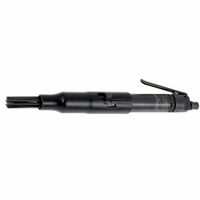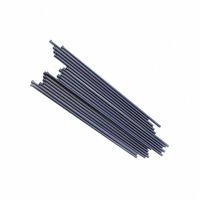Call +(254) 703 030 000 / 751 483 999 / 721 704 777
- Home
- Pneumatics
- Pneumatic Tools
- Needle Scalers Scaling Needles
.....Read More
Frequently Asked Questions
What is a needle scaler used for?
A needle scaler is a pneumatic tool used primarily for surface preparation and cleaning in industrial and construction settings. It consists of a set of fine, needle-like chisels that rapidly oscillate to remove unwanted materials from surfaces. The primary function of a needle scaler is to remove rust, paint, and other coatings from metal surfaces, making it an essential tool in shipyards, automotive repair, and metal fabrication industries.
The tool operates by using compressed air to drive the needles back and forth against the surface, effectively chipping away at the material. This action is particularly useful for cleaning irregular or contoured surfaces where other tools might struggle to reach. Needle scalers are also employed to remove weld slag, corrosion, and other surface contaminants, ensuring a clean and smooth surface for subsequent treatments like painting or welding.
In addition to metal surfaces, needle scalers can be used on concrete to remove laitance or to roughen the surface for better adhesion of coatings or overlays. The adjustable nature of the needle configuration allows for versatility in handling different surface textures and materials.
Safety is a critical consideration when using a needle scaler, as the tool generates noise and vibration. Operators typically wear protective gear, including ear protection, gloves, and eye protection, to mitigate these hazards. The tool's efficiency and ability to access hard-to-reach areas make it a valuable asset in maintenance and repair operations, contributing to the longevity and integrity of structures and machinery.
How does a needle scaler work?
A needle scaler, also known as a needle gun, is a pneumatic or electric tool used for removing rust, scale, and old paint from metal surfaces. It operates by using a set of fine, chisel-tipped rods, or needles, which are housed in a cylindrical casing. These needles are driven back and forth in a rapid, hammering motion.
When the tool is activated, compressed air (in pneumatic models) or an electric motor (in electric models) powers a piston inside the tool. This piston moves back and forth, causing the needles to reciprocate at high speed. The rapid, percussive action of the needles impacts the surface, breaking up and dislodging unwanted material such as rust, paint, or scale.
The needles are typically made of hardened steel and are arranged in a bundle, allowing them to conform to irregular surfaces and reach into crevices. This makes needle scalers particularly effective for cleaning complex shapes and surfaces that are difficult to address with other tools.
The tool's effectiveness can be adjusted by changing the number of needles or the air pressure (in pneumatic models), allowing for control over the aggressiveness of the scaling action. Operators can also replace worn needles to maintain the tool's efficiency.
Needle scalers are commonly used in shipyards, construction, and metalworking industries, where they are valued for their ability to quickly and efficiently prepare surfaces for painting or further treatment. They are also used in maintenance and repair operations to clean machinery and equipment. Safety precautions, such as wearing protective eyewear and hearing protection, are essential due to the noise and debris generated during operation.
What is the difference between a needle scaler and a chisel scaler?
A needle scaler and a chisel scaler are both tools used for surface preparation, but they differ in design, function, and application.
A needle scaler consists of a bundle of fine, hardened steel rods or needles that are housed in a cylindrical casing. When activated, typically by compressed air, the needles rapidly oscillate back and forth. This action allows the tool to effectively remove rust, paint, and other coatings from irregular surfaces. The flexibility of the needles makes the scaler ideal for cleaning uneven, contoured, or hard-to-reach areas. Needle scalers are commonly used in shipyards, construction, and metalworking industries for tasks requiring precision and adaptability to surface contours.
In contrast, a chisel scaler features a single, solid chisel or blade that moves in a reciprocating motion. This tool is designed for more aggressive material removal, such as breaking up concrete, removing tiles, or chipping away at hardened substances. The chisel scaler is less suited for delicate or uneven surfaces due to its rigid, singular impact point. It is often used in demolition, construction, and heavy-duty maintenance tasks where substantial force is needed to remove tough materials.
In summary, the primary difference lies in their construction and application: needle scalers use multiple needles for precision and adaptability on irregular surfaces, while chisel scalers use a single chisel for aggressive material removal on flat or solid surfaces.
Can a needle scaler remove rust?
Yes, a needle scaler can effectively remove rust. A needle scaler is a pneumatic tool equipped with a set of fine, chisel-tipped rods or needles that rapidly oscillate back and forth. This action is highly effective for removing rust, paint, and other surface contaminants from metal surfaces. The tool works by chipping away at the rust layer, breaking it into small particles that can be easily brushed or wiped away.
The effectiveness of a needle scaler in rust removal is due to its ability to reach into crevices and irregular surfaces that other tools might miss. The needles can adapt to the contours of the surface, ensuring thorough cleaning. This makes it particularly useful for complex shapes and hard-to-reach areas.
When using a needle scaler for rust removal, it's important to wear appropriate personal protective equipment, such as safety goggles, gloves, and ear protection, due to the noise and debris generated. Additionally, the surface should be cleaned of loose debris before using the tool to maximize efficiency.
While needle scalers are effective, they may not be suitable for delicate surfaces, as the aggressive action can cause damage. For such surfaces, alternative methods like chemical rust removers or sandblasting might be more appropriate. After using a needle scaler, it's advisable to treat the cleaned surface with a rust inhibitor or primer to prevent future rust formation.
What surfaces can be cleaned with a needle scaler?
A needle scaler is a versatile tool used for surface preparation and cleaning. It is particularly effective on the following surfaces:
1. **Metal Surfaces**: Needle scalers are ideal for removing rust, scale, and old paint from metal surfaces. They are commonly used in shipyards, automotive repair, and metal fabrication industries to clean steel, iron, and other metal surfaces.
2. **Concrete Surfaces**: They can be used to remove coatings, laitance, and other contaminants from concrete surfaces. This is useful in construction and renovation projects where a clean surface is necessary for new coatings or treatments.
3. **Stone Surfaces**: Needle scalers can clean stone surfaces by removing dirt, moss, and other deposits. They are used in restoration projects to clean stone facades, statues, and monuments.
4. **Welds and Joints**: They are effective in cleaning welds and joints by removing slag and spatter, ensuring a clean surface for inspection or further welding.
5. **Wood Surfaces**: Although less common, needle scalers can be used on wood to remove old paint or varnish. Care must be taken to avoid damaging the wood surface.
6. **Industrial Equipment**: They are used to clean machinery and equipment in industrial settings, removing build-up and ensuring efficient operation.
7. **Marine Applications**: In marine environments, needle scalers are used to clean ship hulls, decks, and other metal surfaces exposed to harsh conditions.
8. **Railroad Tracks**: They are used to clean rust and debris from railroad tracks, ensuring proper maintenance and safety.
Needle scalers are effective on surfaces that can withstand the impact of the needles without damage. They are not suitable for delicate or soft materials that could be easily damaged by the tool's aggressive action.
How do you maintain a needle scaler?
To maintain a needle scaler, follow these steps:
1. **Regular Cleaning**: After each use, clean the needle scaler to remove dust, debris, and rust. Use compressed air to blow out any particles lodged in the tool.
2. **Inspect Needles**: Regularly check the needles for wear and tear. Replace any bent, broken, or excessively worn needles to ensure efficient operation.
3. **Lubrication**: Apply a few drops of pneumatic tool oil into the air inlet before each use. This helps in reducing friction and wear on internal components.
4. **Check Air Supply**: Ensure the air supply is clean and dry. Use an air filter and regulator to maintain the correct air pressure and prevent moisture from entering the tool.
5. **Tighten Connections**: Periodically check and tighten all connections, including the air hose and fittings, to prevent air leaks and ensure optimal performance.
6. **Inspect Housing and Components**: Examine the tool’s housing and internal components for cracks or damage. Replace any damaged parts immediately to avoid further issues.
7. **Storage**: Store the needle scaler in a dry, clean environment. Use a protective case or cover to prevent dust accumulation and physical damage.
8. **Follow Manufacturer’s Guidelines**: Adhere to the maintenance schedule and guidelines provided by the manufacturer for specific care instructions.
9. **Professional Servicing**: Periodically have the tool serviced by a professional to ensure all components are functioning correctly and to address any potential issues.
10. **Safety Checks**: Before each use, perform a safety check to ensure all parts are secure and the tool is functioning properly.
By following these maintenance steps, you can extend the lifespan of your needle scaler and ensure it operates efficiently.
What safety precautions should be taken when using a needle scaler?
When using a needle scaler, several safety precautions should be observed to ensure safe operation and prevent injuries:
1. **Personal Protective Equipment (PPE):** Wear appropriate PPE, including safety goggles or a face shield to protect against flying debris, ear protection to guard against noise, gloves to protect hands, and a dust mask or respirator if working in dusty conditions.
2. **Inspect Equipment:** Before use, inspect the needle scaler for any damage or wear. Ensure that all parts are secure and functioning properly. Check the needles for wear and replace them if necessary.
3. **Secure Work Area:** Ensure the work area is well-lit and free of clutter. Secure the workpiece to prevent movement during operation. Keep bystanders at a safe distance.
4. **Proper Handling:** Hold the tool firmly with both hands to maintain control. Use the scaler at the correct angle and pressure to avoid kickback or loss of control.
5. **Air Supply Management:** Ensure the air supply is clean and dry. Use the correct air pressure as specified by the manufacturer to prevent tool damage or malfunction.
6. **Ventilation:** Work in a well-ventilated area to avoid inhaling dust and fumes. Use local exhaust ventilation if necessary.
7. **Regular Breaks:** Take regular breaks to prevent fatigue, which can lead to accidents.
8. **Training:** Ensure that operators are properly trained in the use of the needle scaler and understand the manufacturer’s instructions and safety guidelines.
9. **Emergency Procedures:** Be familiar with emergency shut-off procedures and have a first aid kit readily available.
10. **Maintenance:** Regularly maintain the tool according to the manufacturer’s instructions to ensure it remains in safe working condition.
By adhering to these precautions, the risk of accidents and injuries can be significantly reduced when using a needle scaler.

